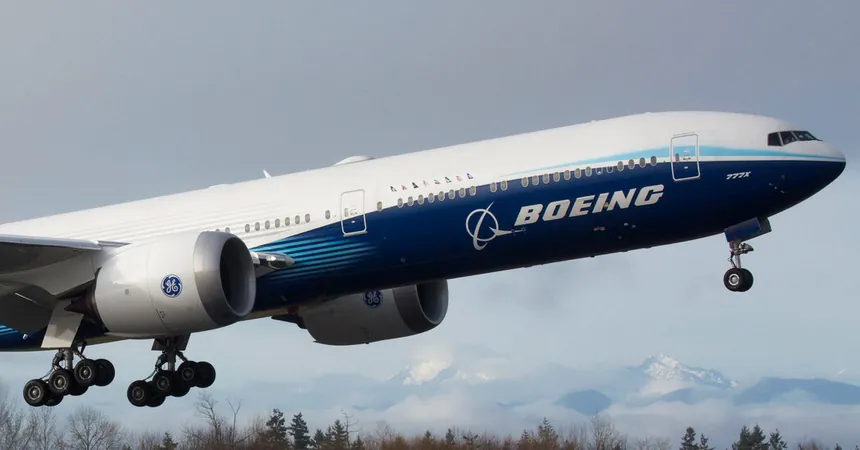
SpaceX Makes History: Catches Rocket Mid-Air Like Something Out of a Sci-Fi Movie!
2024-10-14
Author: Jia
SpaceX Achieves a Historic Milestone
In a stunning display of engineering brilliance, SpaceX achieved a monumental milestone on Sunday by successfully catching the Super Heavy booster of its Starship rocket mid-air upon its return to the launch pad—yes, you read that right! This extraordinary event took place a mere seven minutes after the fifth test flight of the Starship, demonstrating SpaceX's commitment to revolutionizing space travel and opening the door for rapid reuse of rockets.
A Groundbreaking Step for Space Exploration
This achievement marks a groundbreaking step for SpaceX's ambitious plans for human missions to the Moon and Mars. With nobody else approaching such capabilities, the ramifications of this success extend far beyond simple launches; it signals a future where massive payloads can routinely be sent to space, forever changing our interaction with the cosmos.
The Test Flight Experience
The test flight began with a thundering liftoff of the colossal 398-foot-tall (121.3-meter) Starship at 7:25 AM CDT from SpaceX's South Texas launch site. Powered by an awe-inspiring 33 Raptor engines, the Super Heavy booster generated nearly 17 million pounds of thrust, which is twice the power of the legendary Saturn V rocket that once sent astronauts to the Moon over fifty years ago.
Dramatic Descent and Catching the Booster
As the rocket soared into the sky, it reached an impressive altitude of 59 miles (96 kilometers) before beginning its breathtaking return journey. After performing a series of precise maneuvers, the booster reignited its engines for a dramatic descent, ultimately being caught mid-air by the launch tower's mechanical arms, affectionately nicknamed "Mechazilla" and its "chopsticks."
Transition from Splashdowns to Mid-Air Catch
SpaceX's recent efforts to refine its rocket recovery techniques witnessed a successful transition from controlled splashdowns, as seen in previous test missions, to this unrivaled feat of catching a rocket. This success was bolstered by meticulous preparation and an intensive review process involving the Federal Aviation Administration (FAA), who ultimately cleared SpaceX to conduct the endeavor.
Celebration and Focus on Starship's Performance
Once the booster was safely ensnared, celebration erupted among the engineers at SpaceX’s headquarters in Hawthorne, California. However, the attention swiftly turned towards the Starship itself, which also hit a target performance mark during its voyage.
Starship's Reentry and Performance
Designed with cutting-edge heat-resistant stainless steel and thousands of ceramic tiles, Starship reentered Earth's atmosphere amid blazing temperatures, successfully performing a controlled descent before splashing down in the Indian Ocean. Although the ship disintegrated upon impact, its successful reentry and intact landing brought immense pride—showcasing SpaceX's dedication to creating fully reusable space vehicles.
Elon Musk's Vision for SpaceX
SpaceX's CEO, Elon Musk, originally envisioned the concept of catching the Super Heavy booster nearly four years ago, underlining the challenge and ambition inherent in space exploration. While Musk aims for the rapid turnaround of reusable rockets, from weeks currently required for Falcon 9 boosters to just days—or even hours—once implemented in Starship missions.
Collaboration with NASA for Future Missions
But that’s not all—the innovative Starship will serve as NASA's human-rated lunar lander for its Artemis program, with a total contract value of $4 billion. This dynamic collaboration emphasizes the growing synergy between commercial space enterprises and governmental space explorations, setting the stage for future missions to the Moon and beyond.
SpaceX's Growing Capabilities
With plans in motion for multiple launch pads and enhanced manufacturing capabilities, SpaceX is determined to establish itself at the forefront of the space age—poised to make exploration adventures to the Moon and Mars not just a dream, but a reality. NASA Administrator Bill Nelson praised SpaceX’s success and emphasized the importance of continued testing in preparation for future human exploration missions.

 Brasil (PT)
Brasil (PT)
 Canada (EN)
Canada (EN)
 Chile (ES)
Chile (ES)
 España (ES)
España (ES)
 France (FR)
France (FR)
 Hong Kong (EN)
Hong Kong (EN)
 Italia (IT)
Italia (IT)
 日本 (JA)
日本 (JA)
 Magyarország (HU)
Magyarország (HU)
 Norge (NO)
Norge (NO)
 Polska (PL)
Polska (PL)
 Schweiz (DE)
Schweiz (DE)
 Singapore (EN)
Singapore (EN)
 Sverige (SV)
Sverige (SV)
 Suomi (FI)
Suomi (FI)
 Türkiye (TR)
Türkiye (TR)